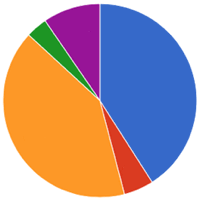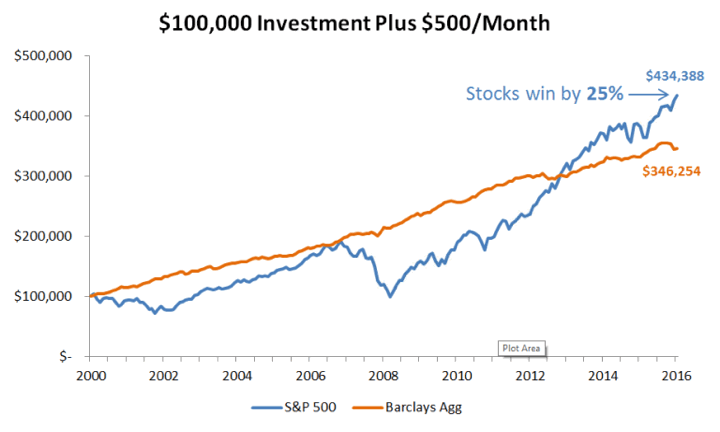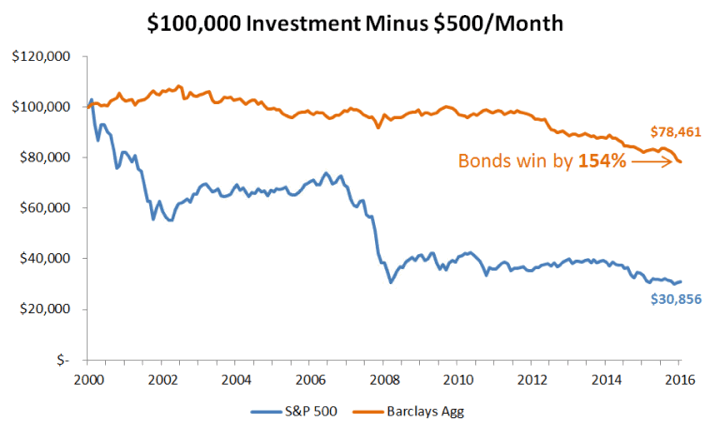
The standard investment advice is the older you get, the more bonds you should hold in your portfolio. There are various rules of thumb like “Age in Bonds” or “Age minus 20 in Bonds”, and so on. On the other hand, stocks have higher historical long-term returns, so shouldn’t we keep as much in stocks as we can?
It’s not just about the long-term average return, you also have to worry about the sequence of returns. I’ve shared a hypothetical example of sequence of returns risk before, but Will Street Project has a great post called Why Drawdowns Matter that illustrates this effect using real-world numbers.
From 2000 to 2016, the overall total return of the S&P 500 Index (large US stocks) and the Barclays US Aggregate Bond Index (broad US bonds) was roughly the same. The sequence for stocks was bad then good. The sequence for bonds was basically a slow, gradual line upwards. Stocks thus lagged bonds for most of the period but caught up and even surpassed bonds a bit by the end.
Here’s what would have happened if you started with $100,000 in either the S&P 500 or the US Aggregate Bond Index and kept on buying $500 per month:

Here’s what would have happened if you started with $100,000 in either the S&P 500 or the US Aggregate Bond Index and kept on selling $500 per month.

The difference is that in the top chart you are adding money (and thus buying stocks at a lower price during the bear markets), while in the bottom chart you are taking out money (and thus selling stocks at a lower price during the bear markets).
It is important to note that things would look different if stocks shot up initially and then tapered off, as opposed to stocks struggling initially but then going back up at then end of the period. However, we can’t control the sequence of returns in our own retirements, so we have to be prepared.
One solution is to hold more bonds (or single-premium immediate annuities). Another solution is to use a dynamic withdrawal strategy so that you’re taking out less money during a down market.
 The Best Credit Card Bonus Offers – March 2024
The Best Credit Card Bonus Offers – March 2024 Big List of Free Stocks from Brokerage Apps
Big List of Free Stocks from Brokerage Apps Best Interest Rates on Cash - March 2024
Best Interest Rates on Cash - March 2024 Free Credit Scores x 3 + Free Credit Monitoring
Free Credit Scores x 3 + Free Credit Monitoring Best No Fee 0% APR Balance Transfer Offers
Best No Fee 0% APR Balance Transfer Offers Little-Known Cellular Data Plans That Can Save Big Money
Little-Known Cellular Data Plans That Can Save Big Money How To Haggle Your Cable or Direct TV Bill
How To Haggle Your Cable or Direct TV Bill Big List of Free Consumer Data Reports (Credit, Rent, Work)
Big List of Free Consumer Data Reports (Credit, Rent, Work)
I’m curious to see what an 80/20 stock/bond portfolio would look like with quarterly rebalancing.
Jonathan, the best solution is not to sell anything at all. Start investing in early 20s and by the time you in late 40s, you have a multi-million dollar portfolio. Then you simply live on dividends. That’s why there is no place for bonds in a portfolio if you have an investing horizon of 25+ years. S&P500 will outperform bonds in such long periods. Am I missing something? Worst case is you will be working well into your 50s. How scary would that be!